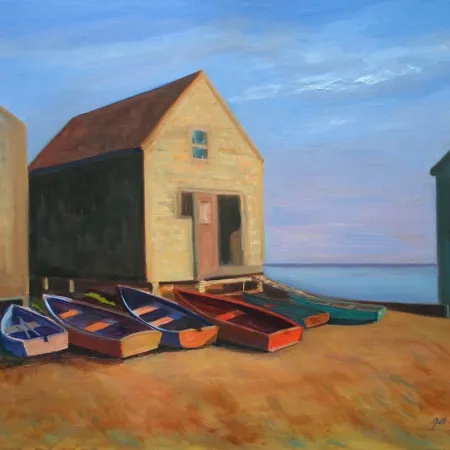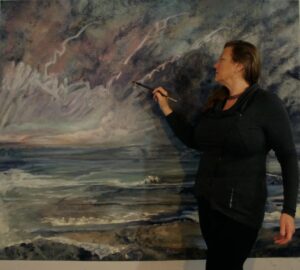
Level: all
Saturday
Jan 20
10:00 am - 4:00 pm
Instructor: Jill Harrington Nichols
Fee: $125
In this workshop, Jill Nichols will teach about color through a variety of short presentations and color exercises that will inform students about color interactions, palettes, value, temperature, saturation, intensity, definitions, and placement in composition, color theory, science, and cultural and psychological meaning. Students will take away an enhanced working knowledge of color, handy reference materials, and nuances of color mixing that will be applied to classroom work and projects in the future.
This class is appropriate for new and experienced artists looking for a better understanding of the relationship between color and value.
In case of snow, there will be a make up date on Saturday, January 27.
Suggested Supply list:
Note that most of the supplies below can be conveniently purchased from the lists that I’ve set up at Dick Blick online at: https://tinyurl.com/
For the workshop: Bring an 11” x 14” wet media (watercolor) pad, with yellow, red, and blue paints, with other essentials listed below.
Paints Recommended Brands: Oil Paint: Budget: Daler-Rowney, Georgian, Lukas/ Good: Gamblin, Utrecht, Grumbacher/ Intense pigments: Old Holland, Williamsburg . Acrylic Paint: Golden or Liquitex Watercolor: Winsor Newton and Turner
Basic Colors- All Mediums
- Yellows: Cadmium Yellow Pale (light or lemon yellow) and Cadmium Yellow Deep, (Cadmium Medium, Hansa, New Gamboge)
- Reds: Alizarin Crimson, Cadmium Red Light, (Magenta, Quinacridone Red Cadmium Red, Naphthol)
- Blues: Ultramarine Blue, Cerulean Blue, (Cobalt, Manganese, Phthalo- note Phthalo colors can be difficult to control)
- Earth Tones: Yellow Ochre, Burnt Sienna, (or Transparent Red Oxide), Burnt Umber
- White: (does not apply to watercolor) Large tube of Titanium, Opaque, and/or Titanium/Zinc mix (more transparent)
Optional/Alternative Colors:
- Ivory Black, Paynes Grey
- Secondaries: Green – Sap and Viridian / Orange – Cadmium and Transparent / Dioxazine Purple
- Oil Paints: Gamblin: Cadmium Chartreuse/ Old Holland: Brilliant Pink and Scheveningen Blue Light/ Williamsburg: Severs/
Kings Blue https://www.dickblick. com/myaccount/blicku/ jx8jt4grcew4h/
Essentials:
- Rags, Viva, or Blue Shop paper towels
- Gloves and/or barrier cream to protect hands.
- Palette- larger the better: Oil or Acrylic-Masterson with a disposable pad/ Watercolor – a deep plate, white enamel tray, plastic
- Oil: Container for solvent-metal with a closable lid works or clean jars, Palette Scraper, Gamsol mineral spirits or Chelsea Classica
- All water-based mediums – Two containers for water
Oil/Acrylic/Casein/Gouache Essentials:
- Quality Brushes: Round – #2 #4, Filbert – #8, #10, #12, Flat or angled– #2, #6, #10, #12, 1” and 2” flat, Small bright
- PRIMED Canvas or panels
- 2 Palette Knives
Watercolor/Gouache Essentials:
- Paints: The old-fashioned solid watercolor tray with colors. Winsor Newton and Turner are good choices for tubes.
- Brushes: Think of it as a good investment, as decent brushes will provide enjoyment for many years to come.
- Sables are the best and most expensive option, Oxhair or soft nylon or a blend of natural and synthetic hairs will also work.
- Brushes to start: #12 round, 7 round, 00,0 or 1 round, 1”, 8 filberts, ½” flat, Japanese calligraphic brush
- Paper: Paper is a large part of the outcome of a watercolor painting. There is a cold or hot press (smoothest).
- If you use a lot of water washes, you will want to use thick cold press paper (300 lb.) rough.
- If you use very little water and like to draw then a hot press, smooth paper works best.
- To begin a pad of inexpensive paper, such as a Canson Watercolor Pad will be fine.
Optional Materials:
- Waxed paper for transport, a Roll of Masking Tape, and Small scissors.
- 9 x 12″ (or similar size) sketchbook, Black Sharpie, Pencils HB, 2B, Sharpener, Erasers, Gum kneaded eraser
- Toned paper, and black and white charcoal pencils for value
- Nutcracker- or pliers to open stubborn tubes.
- Oil: Gamblin non-toxic safflower gel medium
- Acrylic: Retarder to slow down the drying, Gel medium
- Watercolor: Mr. Clean Magic Eraser, natural sponge
About the Instructor:
 Jill Harrington Nichols’ painting explores both the earthbound and outer expanses of our divine cosmos. Her sense of color and composition has developed over the course of 30+ years as a commercial artist. She earned her undergraduate degree at the University of Colorado, Boulder. In 2000, she set her focus on painting, at first training at the Art Students League in NYC, and in 2015 earned her MFA in painting at Western Connecticut State University.
Jill Harrington Nichols’ painting explores both the earthbound and outer expanses of our divine cosmos. Her sense of color and composition has developed over the course of 30+ years as a commercial artist. She earned her undergraduate degree at the University of Colorado, Boulder. In 2000, she set her focus on painting, at first training at the Art Students League in NYC, and in 2015 earned her MFA in painting at Western Connecticut State University.
Her commissioned painting of Washington D.C. appeared as a backdrop for James Comey’s interview on “Face the Nation” while another made its appearance on Showtime’s “The Comey Rule” mini-series. Her artwork “Phi,” celebrating the divine feminine was a part of the “Nasty Woman” art social movement in New Haven and then went on to be installed in the Vatican Observatory Museum.
She has received awards from the U.S. Department of the Interior, National Park Service, and Connecticut Office of the Arts. An active participant in the art communities throughout Connecticut, she has served as vice-president for the Connecticut Plein Air Painters Society and Valley Arts Council and exhibited at the Lyme Art Association, Carriage Barn, Greenwich Art Society, and Lyman Allen Museum.
Jill is an instructor at the Silvermine Art School, in New Canaan, Connecticut, and conducts painting workshops locally and abroad. Jill now offers videos on YouTube and holds real-time online painting critiques.
Artist Statement
My painting is poetry, a lyrical composition of color and light. When painting,
I am in the moment, thoroughly present and enraptured. I experience a sense of
peace, as well as an urgency to capture and share the moment. It is a
privilege to paint. Taking in the invisible birdsong, whispering winds, fragrant
mist, and luminous clouds, often gone before the brush touches the paint.
Inadvertently documenting the vanishing in a slipknot along the
infinite.
